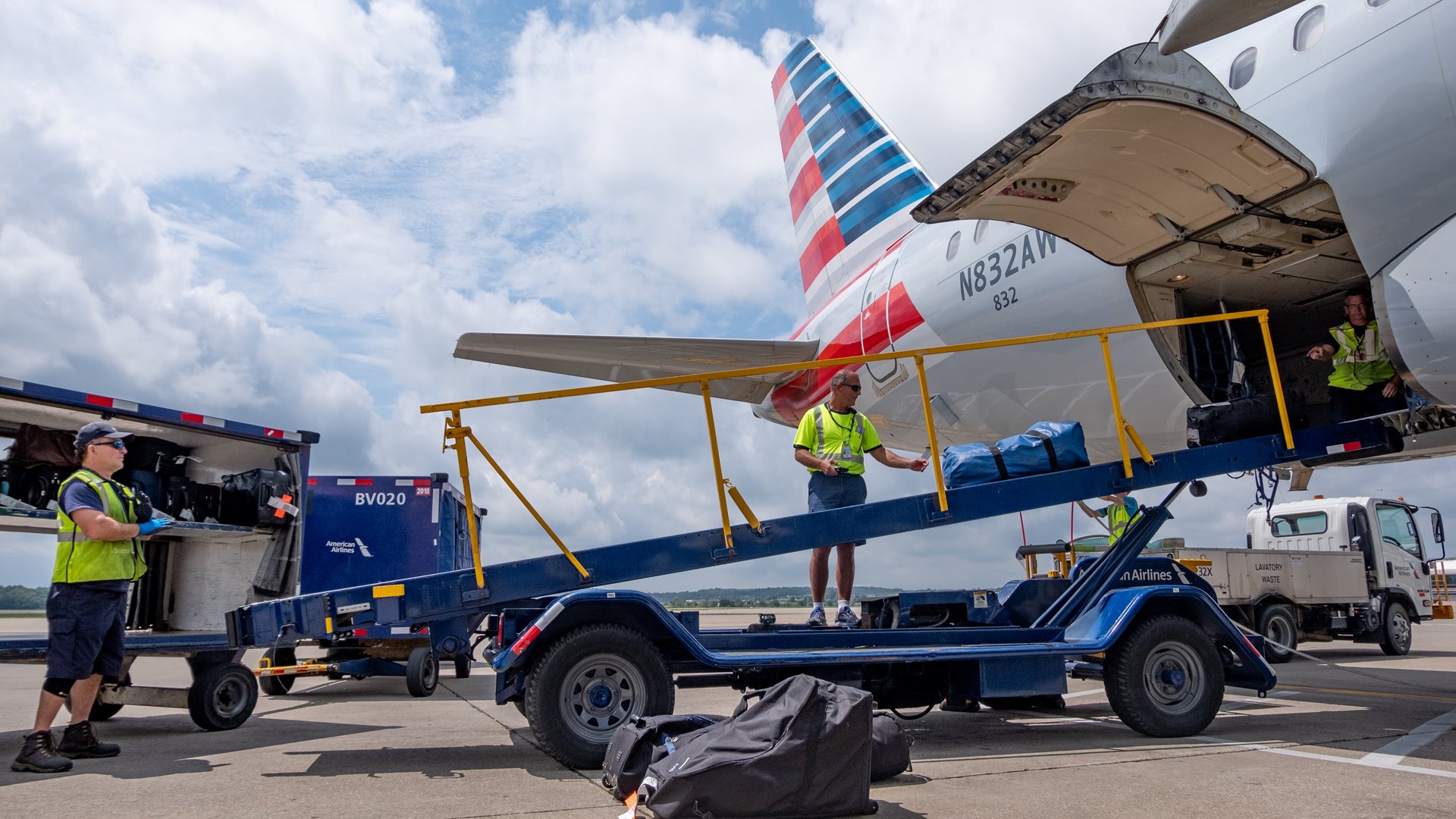The Long and Winding Road That Leads to … Your Bag
Behind the scenes of Pittsburgh International Airport’s baggage system – all eight miles of it.
By Elise Gomez
Published August 23, 2018
Read Time: 4 mins

There you are, standing at the baggage claim, waiting for that light to flash and the baggage carousel to start moving, hoping that the next bag to pop out is yours.
Next to dealing with flight delays, baggage claim is one of the most stressful parts of airline travel. And like many delays, part of the anxiety comes from not really knowing what’s happening behind the scenes.
At Pittsburgh International Airport, more than 60 airport employees oversee and maintain the eight-mile baggage system (the distance from Point State Park to the Pittsburgh Zoo). In addition, hundreds of airline employees are responsible for inputting and unloading baggage. We asked a few of them to roll us through the process for a better view.
American Airline Flight #2085 from Philadelphia lands on runway 28 Left and pulls up to gate B28. This is where Crew Chief Dino Delmastro, a 37-year employee of American Airlines, and his three-person team (two unloaders and a tug cart driver) begin their work.
“Safety is our top priority,” he says as he pulls out earplugs and straps on a neon safety vest. Delmastro’s team ensures the ramp is all clear of debris and equipment is ready for use when the flight lands.
As the flight pulls up, they inspect the aircraft for any damage during flight and make sure their equipment is secure as it is brought up to the cargo hold where the baggage is stored. Then they hook up the preconditioned air and ground power to the aircraft.
Delmastro gives his team the signal and they begin to unload. Baggage is pulled out of the cargo hold near the back of the aircraft and placed on a mobile conveyor belt that rises to the cargo hold. As the luggage goes down the conveyor belt, he scans it with a reading device.
“We do this so the passenger knows exactly where their bag is when it lands at the airport,” he said.
The tug cart driver, with three to four carts loaded with baggage, then heads for one of two airport baggage system matrixes. Baggage for all American Airlines flights — which comprises about 25 percent of all flights at PIT — gets sorted at the North Matrix. The South Matrix handles all other airlines for incoming flights.
Once bags are placed on this system, their journey begins, although most bags don’t travel all eight miles.
Bags travel from the Airside Matrix through a dark, narrow underground tunnel. After traveling a quarter-mile through the tunnel, the luggage arrives in the Landside Matrix, where it is sorted by a Baggage Sortation Message. This system automatically scans the tag that is put on the luggage by the airline to determine the appropriate baggage carousel.
Jaime Meyers, Airline Services supervisor, is an airport employee who works with baggage operators to make sure that bags flow seamlessly through all of the systems and are sent to the appropriate claim. Even with checks and balances, things can still go awry and delays ensue.
“Years back, we had a styrofoam cooler with dry ice and live lobsters in it,” Meyers said. “The cooler was in the system and hit by a pusher (bag sorter) and it broke open, and we had lobsters all over the place. We were finding them three weeks later because of the smell. Needless to say, that passenger did not end up getting their dinner that night.”
After the bag passes Meyers and his colleagues, it continues down a long, winding system of conveyor belts. At this point, the luggage hits a pusher which sends each bag to the appropriate airline baggage claim carousel. PIT has 16 airlines with a total of 12 carousels. Three of them are used for American Airlines baggage.
Beep, beep, beep. The baggage carousel turns on, and a 20-minute ride through the system is over.
Seeing your green suitcase with the bright pink bow push through the film curtains — priceless!
Modernizing the System
Approximately 4.5 million pieces of luggage are processed through the baggage system at PIT annually. And for the airport employees managing the operation, ensuring a smooth process is crucial.
There can be many reasons for a delayed or missing bag, such as inclement weather, a broken baggage belt, bag and belt jams, or mistagged baggage at the airline ticket counter.
“Our passengers are traveling all over the world for vacations, graduations, weddings, business and much more,” said Kevin Kosmal, Airline Services Supervisor and part of the startup crew that arrives at the airport at 3 a.m. to prepare for daily operations. “We never want to inconvenience a passenger by losing their bag in the system.
“We make every effort we can to ensure the bag is united with the passenger at the end of their trip.”
At its inception in 1992, PIT had the largest airport baggage delivery system in the U.S. And while the eight-mile system was once state of the art, changes in technology, along with the airport’s transition from a mega-hub to an origin-and-destination airport, mean updates are needed, officials say.
The Terminal Modernization Program, expected to be completed in 2023, is an opportunity to again make PIT’s baggage system one of the industry’s best, according to Paul Hoback, Senior Vice President, Engineering, Planning & Capital Development.
“The improved system will lower the cost for our airline partners to fly out of Pittsburgh, improve performance metrics and ensure that more bags make it to their final destination on time,” said Hoback.
The modernization program will look to expedite baggage delivery by consolidating the systems into a more efficient operation in a centralized location of the upgraded terminal. Additionally, improved technology will enhance the screening and tagging process.
Waiting for bags, according to Hoback, could become a thing of the past.






